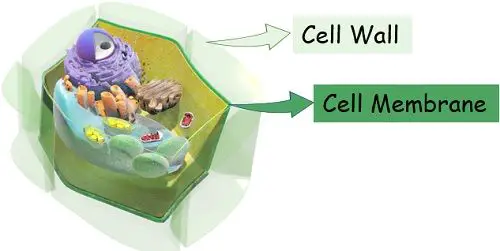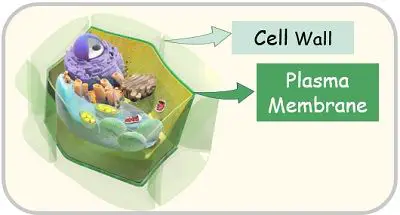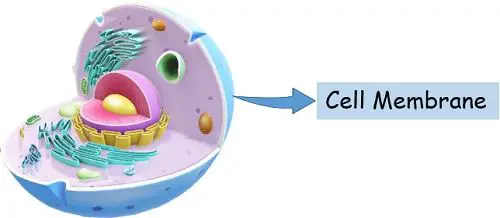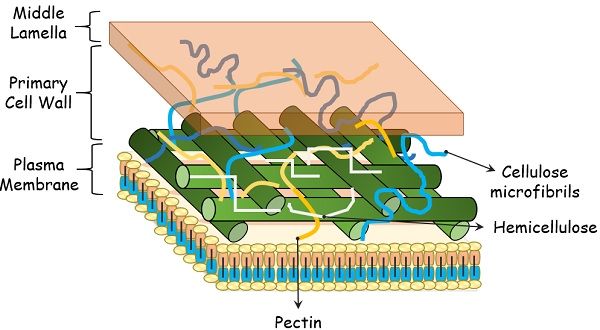The plasma membrane is the outermost covering of animal cells that separates the internal cellular environment from the external. But the cell wall serves the role of the outer protective layer in plant, bacterial and fungal cells.
The plasma membrane is a semi-permeable layer that allows only some selective substances to pass through it. It is a thin, delicate and flexible layer with a thickness ranging from 5-10 nm.
While the cell wall is fully permeable, it permits most of the elements to enter the cell. The plasma membrane is metabolically active, but the cell wall is not. It is a comparatively thick and rigid layer, with 4-20 µm of thickness.
The following content will illustrate the key differences between the plasma membrane and cell wall.
Content: Plasma Membrane Vs Cell Wall
- Comparison Chart
- What is a Plasma Membrane?
- What is a Cell Wall?
- Key Differences
- Similarities
- Conclusion
Comparison Chart
| Basis For Comparison | Plasma Membrane | Cell Wall |
|---|---|---|
| Meaning | Plasma Membrane is a delicate, thin structure of around 5-10nm wide and is visible under electron microscope, and it is present in all types of cell, helps in the passage of molecules and protects the protoplasm. | Cell Wall is a thick, rigid structure of around 4-20um wide and is visible under light microscope; it is present in plant cell, bacterial and fungal cell, helps in providing shape and rigidity to the cell. |
| Presence | Plasma Membrane is present in all types of cells. | Cell Wall is present in the plant cell, bacteria, fungi and algae. |
| Composition | Made up of lipids and proteins and carbohydrates. | Made up of cellulose (plant cell), chitin (fungi), and peptidoglycan (bacteria). |
| Structure | Thin layers and is visible only through the electron microscope. | Thick layers which are visible through the light microscope. |
| Permeability | Semi-permeable. | Completely permeable. |
| Receptors | Plasma membrane have receptors, helps in cell-cell communication. | Cell wall does not have receptors. |
| Metabolic function | Metabolically active and living. | Inactive and non-living. |
| Thickness | Same thickness throughout its life. | Thickness grows with life. |
| Nutrition | Need proper nutrition to survive. | Doesn't need any nutrition from cell but deposition instead. |
| Functions | 1.Protects protoplasm. 2.It separates the components present inside to outside environment. 3.Helps in cell-cell communication. 4.It allows the passage of molecules | 1.Cell wall provides rigidity to the cell, protect the cell from external shock and other mechanical forces. 2.It is responsible for cell morphology. 3.It prevents large molecule to enter into the cell. 4.Also, prevent the cell from being toxic. 5.Helps in maintaining the osmotic environment of the cell. |
What is Plasma Membrane?
We often refer to the plasma membrane as Cell Membrane or Plasma Lemma. It is present in all kinds of cells as a flexible outer layer maintains the cell body’s proper shape.
The cell membrane is semi-permeable in nature. Thus, it allows only some selective molecules to pass through it and enter the cell. You can assume it as a gatekeeper that keeps the check on the individuals coming in and out. For this reason, it is responsible for controlling the traffic of the molecules inside the cell.
Other than that, they separate the internal cellular atmosphere from the external environment, thereby protecting and maintaining a stable internal cell environment.
Composition of Cell Membrane
The primary components of the cell membrane are proteins and lipids. Their ratio varies depending upon the function of that specific cell.
There are three types of classes of amphipathic lipids present in the cell membrane structure.
- Phospholipids
- Glycolipids
- Sterol
Among the above, phospholipids are most abundantly found. Whereas the cholesterol remains dispersed throughout the animal cell. Also, the liposomes stay in the cell membrane; they are enclosed in circular pockets by a lipid bilayer. Proteins were positive and alive in time.
Models of Plasma Membrane
Why is it called a Plasma membrane?
The cell contains plasma, i.e. protoplasm, which is a semifluid living matter in which the cell organelles remain submerged. A cell membrane is a multifaceted membrane that envelops this cellular plasma. Thus, it is referred to as the Plasma membrane.
What are the functions of the Cell Membrane?
The plasma membrane performs many tasks simultaneously to continue and maintain the optimal functioning of a cell. The following are some common functions that the cell membrane carries out:
- Maintaining the integrity of the cell: The cell membrane serves the role of anchor associated with the cytoskeleton. This provides the cell with a definite shape and structure.
- Gatekeeping to the entry and exit of the molecules: It keeps a keen check over the elements entering and exiting the cell. And allows only some selective molecules to pass through it. Thus, we refer to it as selectively permeable in nature.
- Signal Transduction: The plasma membrane is embedded with certain receptors that assist the cell in sending and receiving the signals from its surrounding.
- Intercellular Junction: These junctions are where the boundaries of two adjacent cells meet. By means of them, the two cells can adhere and interact with each other.
- Cellular communication and recognition: The same cells performing the same function form a tissue. The cells continuously communicate with each other to work in unison.
- Cellular Transport: The plasma membrane facilitates the transport of the material from inside to outside and vice versa. Several transport proteins remain embedded in the layer that aid the transport mechanism as per the cell’s need.
- Protection and Cell defence: Insulates the interior components of the cell. Also, it supplies the adequate mechanical support to defend the outside shock and harmful agents
What is Cell Wall?
There is an additional layering on top of the plasma membrane in certain cells. This upper layer is nothing but the Cell wall.
We can define it as “A non-living rigid outermost covering that maintains the structural integrity of cell“.
Characteristics of Cell wall
- Outermost layer
- Semi-transparent
- Supportive
- Porous
- Rigid
Generalised structure of the Cell wall
You can assume that if a cell is like a delicate balloon with a thin lining, then the cell wall is the cardboard box surrounding the balloon shielding it from any external harm.
Its multi-layered structure consists of three distinct zones- Middle lamella, primary cell wall, and secondary cell wall. Sometimes, the plant cell may possess middle lamella and a primary cell wall but lack a secondary cell wall.
- Middle lamella: This is the outermost cell wall layer composed of polysaccharides, i.e., pectin. Their major role is to bind or adhere to the adjacent cell firmly.
- Primary cell wall: This lies between the middle lamella and plasma membrane in the plant cells. Generally composed of cellulose microfibril. And gel-like matrix of fibres of hemicellulose and pectic polysaccharides.
The main function of the primary cell wall is to supply flexibility and strength to the cell. It also comprises minute pores named plasmodesmata that create the channels that help in direct communication from one cell to another.
- Secondary cell wall: It is developed once the primary cell wall stops growing. You can say that it is a non-dividing matured form of the primary cell wall. It is quite hard, thus enhancing the strength of the cell. Also, it aids in the extra protection of the cell.
It lies between the primary cell wall and the plasma membrane. In addition to cellulose, hemicellulose also has lignin that increases its hardness and assists the water conductivity of the plant tissues.
Functions of Cell Wall
- Provides definite shape to the cell.
- Prevent mechanical damage to the internal cell organelles.
- Aids cell-to-cell interaction.
- Prevents infection by restricting the undesirable entities.
- Counteracts the osmotic pressure.
- Protects protoplasm from external injury.
- Provides strength to the plant cell so as to withstand the gravitational force.
- The growth of the cell wall leads to cell expansion.
- Suberin and cutin reduce the water occurring via transportation.
Chemical Composition of Cell walls
The cell wall is made up of different chemical components in plants.
The chemical composition of the cell wall differs in plants, bacterial and fungal cells.
Mainly it is made from chitin, cellulose, glucans etc. Sometimes it also possesses minerals like calcium carbonate.
Matrix
- Water- 60%
- Hemicellulose- 5-15%
- Pectin – 2-8%
- Lipids -0.5-3.0%
- Proteins -1-2%
Microfibrils
- Cellulose
- Fungus cellulose
- Mucopolymer
Other ingredients
- Lignin (Strength)
- Cutin (prevents water loss)
- Mineral ions
- Silica (Stiffness)
- Suberin (Impermeability)
Key Differences Between Plasma Membrane and Cell Wall
- Plasma Membrane is the phospholipid layer present in all types of cells. It is very fragile and delicate with 5-10nm thickness. While Cell Wall is the rigid outermost layer present in the plant cell, bacterial and fungal cells only. It is made up of cellulose, and peptidoglycan or chitin with a thickness of 4- 20um.
- Plasma Membrane is metabolically active and living. While the Cell wall is metabolically inactive and non-living.
- The plasma Membrane requires nutrition to grow while the Cell wall doesn’t require nutrition to grow.
- Plasma Membranes are semipermeable and have receptors which help in cell-cell communication. Whereas the Cell wall is completely permeable and does not have any receptors.
- Plasma Membrane protects protoplasm and checks the entry of molecules. Hence it is a semi-permeable membrane, that also helps in cell-cell communication. While the cell wall provides rigidity and protection from external shock to the cell.
Similarities
- Give shape to the cell.
- Provide support and rigidity for the cell.
- Regulate the incoming and outgoing molecules.
- Provide protection.
Conclusion
From the above discussion, we conclude that both the layers of the cell provide protection, rigidity, and shape to the cell, though their composition is different their presence is worthy, as they protect the cell.





Nakwel Wilex says
Very helpful websites